You can eliminate garden caterpillars by mixing 1-2 tablespoons of neem oil with one gallon of water and a few drops of mild dish soap as an emulsifier. This natural mixture contains azadirachtin, which disrupts caterpillar feeding and growth while preserving beneficial insects. Apply the spray every 7-14 days during early morning or late afternoon, ensuring you cover leaf undersides thoroughly. For heavy infestations, use the concentrated two-tablespoon formula to maximize effectiveness and protect your garden ecosystem naturally.
Understanding Neem Oil’s Natural Properties Against Caterpillars
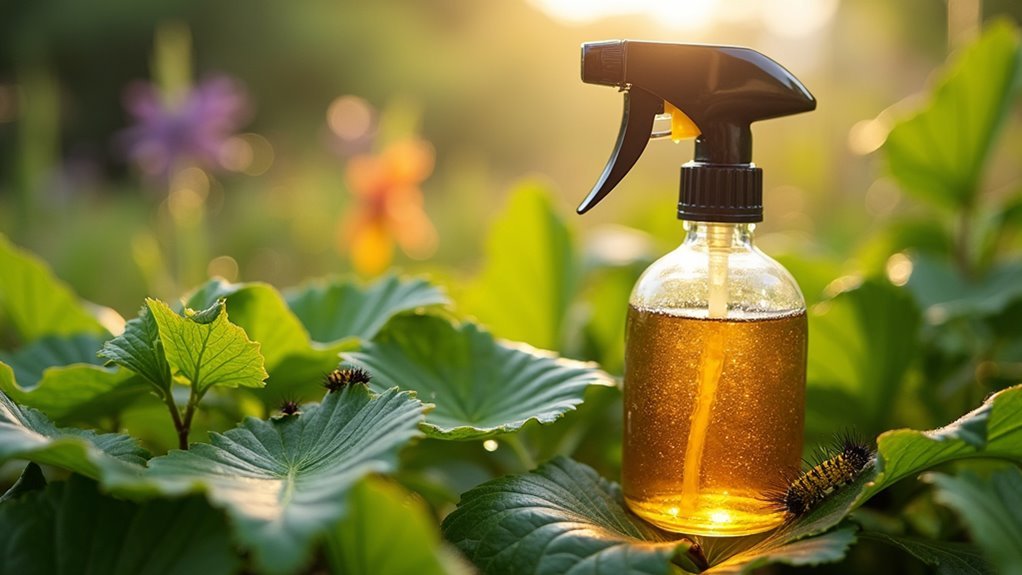
Neem oil’s potency against garden caterpillars stems from azadirachtin, a powerful compound found in neem tree seeds that disrupts these pests’ growth and feeding behaviors.
When you apply this natural pesticide to your plants, it works as a suffocating agent that prevents caterpillars from breathing properly, ultimately leading to their elimination.
What makes neem oil particularly valuable is its selective action.
While it’s highly effective against destructive caterpillars, it won’t harm beneficial insects like bees and ladybugs that you want to keep in your garden.
This makes it perfect for organic gardening practices where you’re trying to maintain a healthy ecosystem while controlling harmful pests naturally and safely.
Essential Ingredients for Effective Neem Oil Caterpillar Spray
You’ll need two key components to create an effective neem oil spray that targets caterpillars in your garden. The foundation starts with pure neem oil, which contains the active compounds necessary to disrupt caterpillar life cycles and deter future infestations. You’ll also require a natural emulsifying agent like mild dish soap to help the oil blend properly with water and guarantee even coverage on your plants.
Pure Neem Oil Base
When creating an effective caterpillar control solution, you’ll need just three essential ingredients to build your pure neem oil base.
This natural pesticide works by suffocating and repelling caterpillars while remaining safe for beneficial insects when applied correctly.
Your pure neem oil mixture requires these components:
- Pure neem oil – Use 1 to 2 tablespoons derived from neem tree seeds
- Water – Add 1 gallon of clean water as your dilution base
- Mild dish soap – Include a few drops to help emulsify the mixture
- Proper application timing – Apply every 7 to 14 days during peak caterpillar activity
This simple combination creates a powerful organic gardening solution that targets harmful caterpillars without compromising your garden’s ecosystem.
Natural Emulsifying Agents
Since oil and water naturally repel each other, adding the right emulsifying agent becomes essential for creating an effective neem oil spray that’ll actually stick to caterpillars and plant surfaces.
Natural emulsifying agents like liquid soap or Castile soap solve this mixing problem by helping neem oil distribute evenly throughout your water-based solution.
When you use these emulsifiers, you’ll dramatically increase neem oil’s effectiveness. The soap allows the oil to coat caterpillar bodies more thoroughly, enhancing the suffocating action that kills these pests.
Mix 1-2 teaspoons of liquid soap per gallon of neem oil solution for best results.
These natural emulsifying agents also reduce potential plant damage, making your mixture safer.
Always test on a small plant area first to prevent adverse reactions before applying widely.
Basic Neem Oil and Water Mixture Recipe
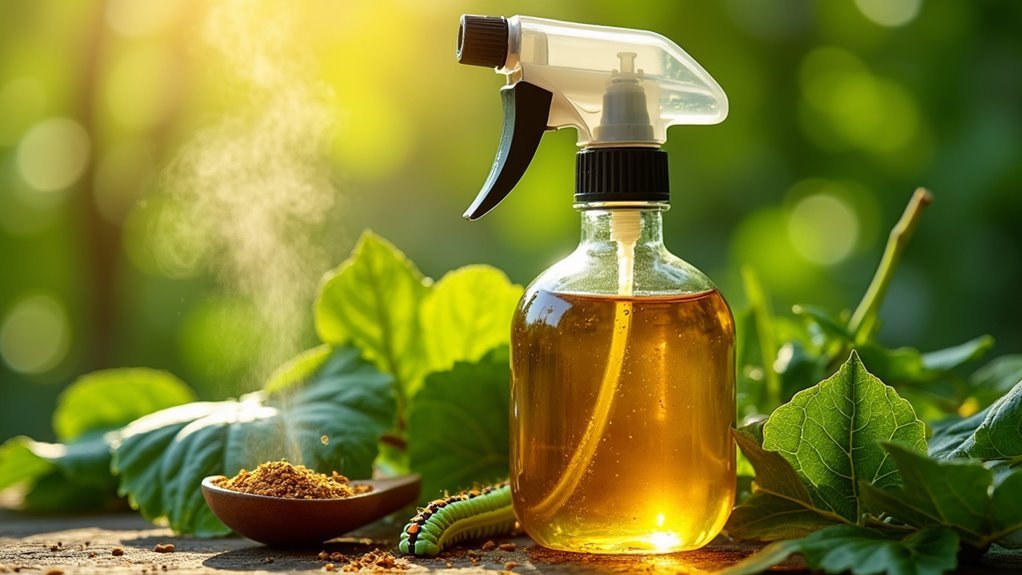
Creating an effective neem oil solution requires just three simple ingredients that you likely already have at home.
This basic mixture provides powerful pest control against caterpillars without harsh chemicals.
Here’s what you’ll need for one gallon of solution:
- 1-2 tablespoons of neem oil – the active ingredient that deters pests
- One gallon of water – serves as the carrier for even distribution
- A few drops of mild dish soap – acts as an emulsifier for better adhesion
- Thorough mixing – prevents clumping and guarantees effectiveness
Mix these ingredients completely before spraying directly onto affected plants.
Focus on leaf undersides where caterpillars hide.
You’ll need to reapply every 7-14 days, especially after rain, to maintain ideal pest control results.
Enhanced Neem Oil Formula With Dish Soap Emulsifier
While the basic neem oil mixture works well, you’ll achieve superior results by upgrading to an enhanced formula that incorporates dish soap as a dedicated emulsifier. This enhanced neem oil formula guarantees uniform mixing with water for maximum effectiveness against caterpillars.
| Ingredient | Amount |
|---|---|
| Neem oil | 2 tablespoons |
| Dish soap | 1 teaspoon |
| Water | 1 gallon |
| Coverage period | Up to 2 weeks |
Spray this mixture directly onto affected plants, saturating both leaf tops and undersides where caterpillars hide. The formula suffocates caterpillars on contact while leaving a protective residual layer that repels pests for two weeks. Always test on a small plant section first to check for adverse reactions before broader garden application.
Concentrated Neem Oil Treatment for Heavy Infestations
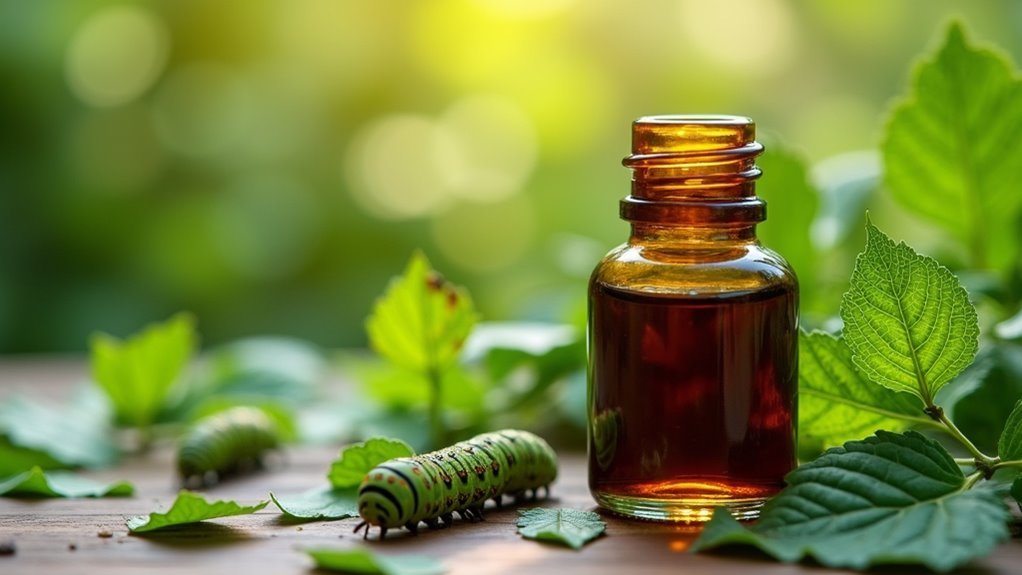
When you’re dealing with a severe caterpillar problem, you’ll need to identify the telltale signs of heavy infestation before applying a stronger neem oil solution.
Look for extensive leaf damage, visible caterpillar clusters, and heavy defoliation across multiple plants in your garden.
You’ll then need to increase your neem oil concentration and adjust your application technique to effectively combat these larger populations.
Heavy Infestation Identification Tips
How can you tell if your garden faces a severe caterpillar invasion that requires concentrated neem oil intervention?
You’ll notice clear warning signs that distinguish heavy infestations from minor pest problems.
Look for these telltale indicators of serious caterpillar infestation:
- Significant defoliation – Your plants show extensive leaf damage with large sections completely stripped bare.
- Visible caterpillars – You can easily spot multiple caterpillars crawling on plant surfaces during daylight hours.
- Abundant frass deposits – Dark, pellet-like droppings accumulate beneath infested plants in noticeable quantities.
- Rapid damage progression – Plant deterioration accelerates daily, with new damage appearing faster than plants can recover.
When you identify these symptoms together, it’s time to implement concentrated neem oil treatment immediately to prevent complete plant destruction.
Concentrated Application Methods
After confirming heavy caterpillar damage in your garden, you’ll need a more aggressive neem oil approach to regain control.
Mix two tablespoons of concentrated neem oil with one gallon of water to create a potent treatment solution. Add a few drops of mild dish soap to improve adherence and penetration against stubborn caterpillar populations.
Before full application, test this mixture on a small plant area to check for adverse reactions.
Spray directly onto both upper and lower leaf surfaces where caterpillars typically hide, ensuring thorough coverage of all affected plants.
Reapply your neem oil treatment every 7 to 14 days to maintain peak effectiveness and establish lasting pest control throughout your garden.
Neem Oil and Garlic Combination for Added Deterrent Power
While neem oil alone provides effective caterpillar control, combining it with garlic creates a double-action defense that’s tough for garden pests to overcome.
This neem oil and garlic combination for added deterrent power works by suffocating caterpillars while garlic’s strong aroma provides natural repellent properties.
Here’s how to create this powerful organic solution:
- Crush two tablespoons of garlic and blend with one quart of water
- Add one tablespoon of neem oil to the mixture
- Let the solution steep for at least 24 hours before straining
- Apply every 7 to 14 days for consistent protection
The neem oil disrupts caterpillars’ hormonal systems, preventing maturation and reproduction.
This eco-friendly combination remains safe for beneficial insects while maintaining your garden’s health.
Proper Application Techniques for Maximum Caterpillar Control
You’ll achieve the best caterpillar control when you master three critical application techniques that determine neem oil’s effectiveness.
Your spray coverage method directly impacts how well the oil reaches caterpillars hiding on leaf undersides, while proper timing prevents plant damage and maximizes absorption.
Getting the concentration ratio right guarantees you’re creating a lethal barrier for pests without harming your plants.
Optimal Spray Coverage Methods
When targeting garden caterpillars with neem oil, proper mixing creates the foundation for effective control. Your neem oil mixture requires precise preparation to achieve ideal spray coverage methods that’ll eliminate these destructive pests.
Follow these essential steps for maximum effectiveness:
- Mix thoroughly – Combine 1-2 tablespoons of neem oil per gallon of water for a 1-2% concentration that properly coats foliage.
- Time your application – Spray during early morning or late afternoon to prevent rapid evaporation from direct sunlight.
- Use fine mist settings – Guarantee even coverage on leaf tops and undersides where caterpillars typically hide.
- Reapply consistently – Treat every 7-14 days, especially after rainfall that washes away protection.
Always test on a small plant section first to prevent adverse reactions.
Timing and Frequency
Success with neem oil caterpillar control depends heavily on establishing the right application schedule and maintaining consistent treatment intervals.
You’ll need to apply neem oil every 7 to 14 days for maximum effectiveness against caterpillar populations. Time your applications during early morning or late afternoon hours to prevent direct sunlight from degrading the oil and reducing its potency.
Before starting your regular treatment schedule, test a small plant area and wait 24 hours to check for adverse reactions.
During application, thoroughly saturate the entire plant, paying special attention to leaf undersides where caterpillars typically hide.
After each neem oil treatment, monitor your garden consistently to assess pest levels and determine whether additional applications are necessary for complete caterpillar elimination.
Neem Oil Concentration Ratios
Getting the concentration right makes all the difference in your neem oil’s effectiveness against garden caterpillars. The proper neem oil concentration ratios guarantee you’re not wasting product while maximizing pest control results.
Follow these essential mixing guidelines:
- Standard concentration: Mix 1 to 2 tablespoons of neem oil per gallon of water for effective caterpillar control.
- Emulsification: Verify the solution is well emulsified before application to maintain consistency.
- Soap additive: Add a few drops of mild dish soap to enhance adherence to plant surfaces.
- Coverage application: Apply thoroughly to both upper and lower leaf surfaces where caterpillars hide.
These concentration ratios provide ideal balance between effectiveness and plant safety, giving you reliable protection against destructive caterpillars.
Timing and Frequency Guidelines for Neem Oil Treatments
Although neem oil proves highly effective against garden caterpillars, you’ll achieve the best results by following specific timing and frequency guidelines that maximize its pest-controlling properties.
Apply neem oil treatments every 7 to 14 days for peak effectiveness against caterpillars and other garden pests. You’ll prevent leaf burn by spraying during cooler temperatures in early morning or late afternoon hours.
Ensure thorough coverage by saturating both leaf surfaces, especially undersides where caterpillars typically hide.
Reapply neem oil after rainfall or heavy watering since water washes away the protective barrier.
Monitor your garden consistently for pest activity, adjusting application frequency based on infestation severity. More frequent treatments may be necessary during heavy caterpillar outbreaks.
Safety Precautions When Using Neem Oil in Gardens
While neem oil offers an effective solution for caterpillar control, you must take proper safety precautions to protect yourself and your garden’s ecosystem during application.
Essential safety precautions when using neem oil in gardens include:
- Wear protective gear – Always use gloves and a mask when handling concentrated neem oil to prevent skin irritation and avoid inhaling fumes that can trigger allergic reactions.
- Dilute properly – Mix 1-2 tablespoons of neem oil with one gallon of water to guarantee safe application and prevent plant damage.
- Test first – Apply neem oil to a small plant section before widespread use to check for sensitivity reactions.
- Time applications wisely – Apply during early morning or late afternoon to avoid leaf burn and protect beneficial insects like bees and butterflies when they’re less active.
Monitoring and Reapplication Strategies for Long-Term Protection
Since neem oil’s effectiveness diminishes over time, you’ll need to establish a systematic monitoring and reapplication schedule to maintain long-term caterpillar control in your garden.
Check your plants regularly for caterpillar presence and damage on both leaves and stems to catch infestations early. Reapply neem oil every 7 to 14 days, especially after rainfall or heavy watering that washes away treatments.
Apply during early morning or late evening when beneficial insects are less active. During inspections, look for caterpillar eggs to prevent larger infestations from developing.
Keep a treatment log documenting application dates and observations. This consistent approach helps you track neem oil’s effectiveness and adjust your strategies as needed for ideal protection.
Frequently Asked Questions
How to Use Neem Oil for Caterpillars?
You’ll mix 2-4 tablespoons of neem oil per gallon of water, then spray all plant surfaces including leaf undersides. Test first on small areas, then reapply every 7-14 days for effectiveness.
What Is the Best Homemade Caterpillar Killer?
You’ll find neem oil mixture works as the most effective homemade caterpillar killer. Mix two tablespoons neem oil with one gallon water plus dish soap, then spray directly on affected plants every week.
What Is the Ratio of Neem Oil to Water?
You’ll want to mix 1-2 tablespoons of neem oil per gallon of water for general pest control. Add a few drops of liquid soap to help emulsify the mixture effectively.
What Is the Mixture for Neem Oil on Garden Plants?
You’ll mix 1-2 tablespoons of neem oil with 1 gallon of water, adding several drops of mild liquid soap. Shake well before applying, then spray directly onto plants, especially leaf undersides.
In Summary
You’ve now got the knowledge to tackle caterpillar problems naturally with neem oil mixtures. Start with the basic water solution and escalate to concentrated formulas for stubborn infestations. Remember to apply during cooler hours, reapply after rain, and always test on small plant sections first. With consistent monitoring and proper timing, you’ll protect your garden effectively while keeping harmful chemicals away from your plants and beneficial insects.

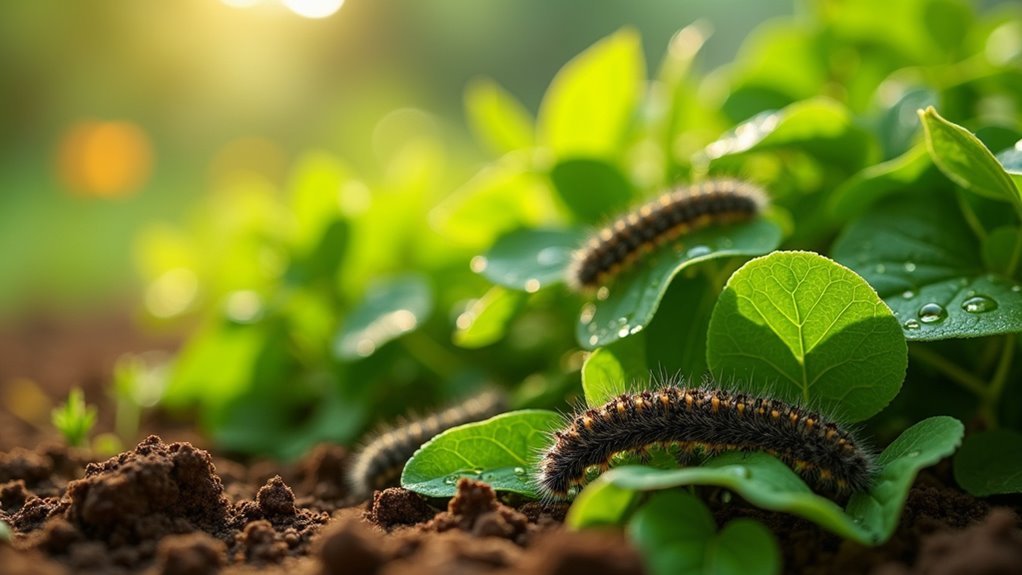
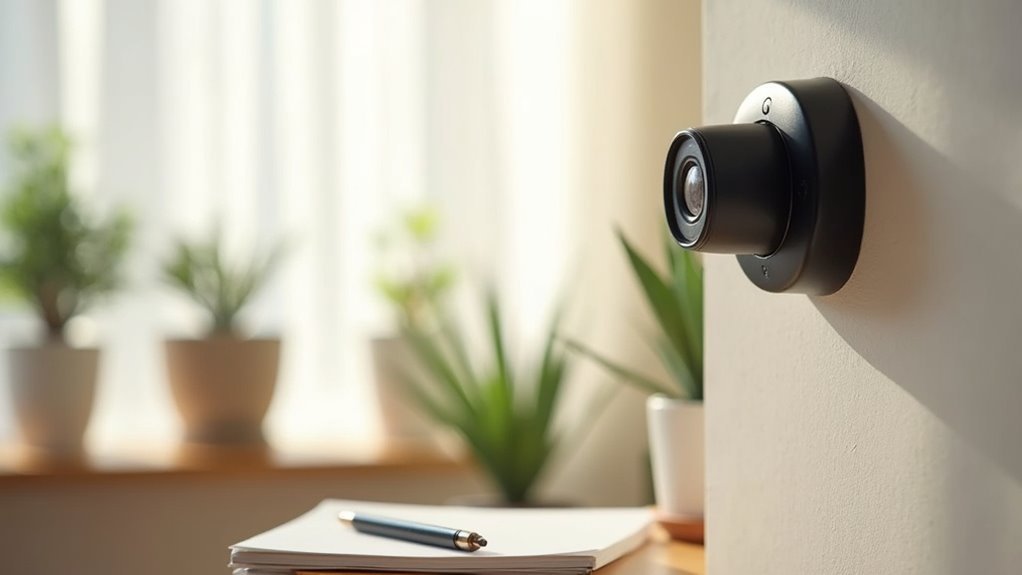

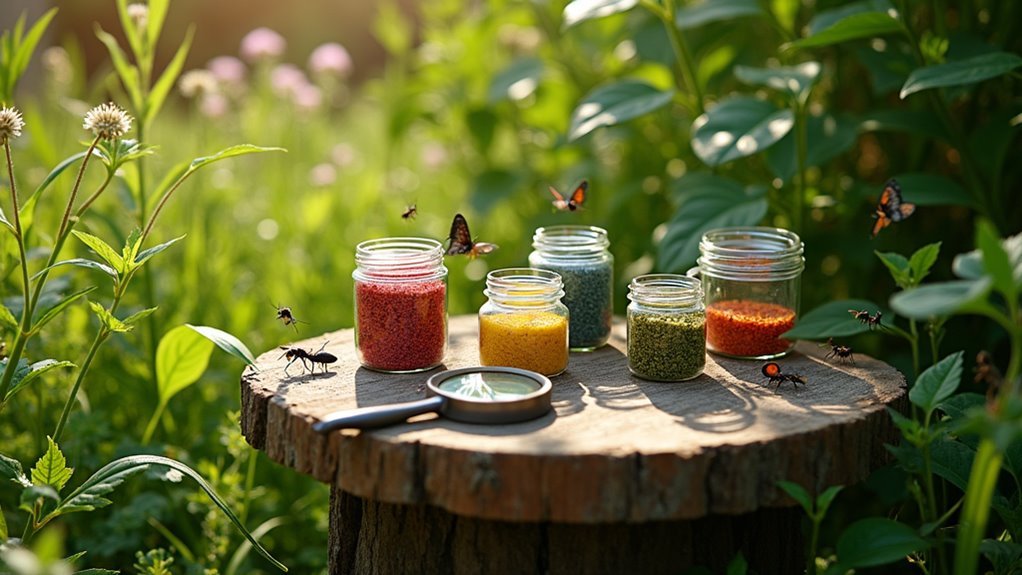
Leave a Reply